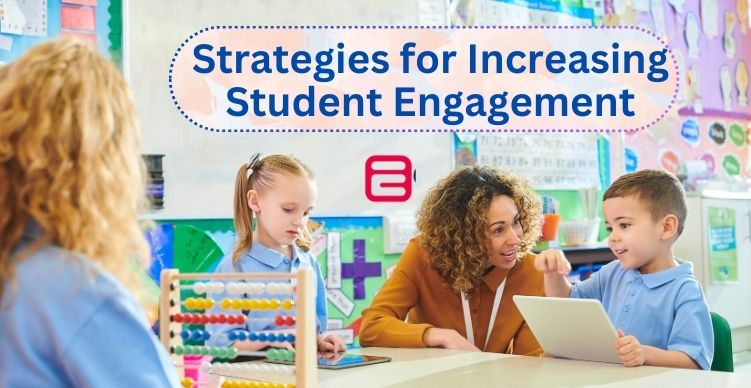A proper education requires a lot of things besides studies. Student engagement is one of them. However, bringing this engagement into class can be difficult. Whether it’s a frightened kid or the entire class that can’t stop moving, educators worry about how to keep people interested and focused on their academic objectives.
Engaged students learn critical life skills in addition to more efficiently absorbing academic material. In this article, we will discuss some actionable strategies for raising student engagement that you may use from this writing.
Understanding Student Engagement
Student engagement is a multifaceted concept that encompasses students’ emotional, cognitive, and behavioral investment in their learning. It goes beyond mere attendance. It has to do with how passionate and engaged pupils are with their studies. Active participants who voluntarily investigate, challenge, and fully immerse themselves in their studies are known as engaged students.
Factors Affecting Student Engagement
Classroom Environment
The physical and emotional ambiance of the classroom sets the stage for engagement. An inviting and safe space fosters a sense of belonging. It empowers learners to assume responsibility for their educational path. Students are more willing to communicate and work together when they feel accepted.
Teacher-Student Relationship
The interaction between instructors and students is an essential component of involvement. It’s about more than just sharing knowledge. It is about building empathy and mutual respect. Students engage more when they feel welcomed by teachers.
Course Content and Delivery
The very essence of what and how teachers teach profoundly influences engagement. Course content should be relevant, relatable, and thought-provoking. Effective delivery methods involve a mix of lectures, interactive discussions, hands-on activities, and multimedia resources that cater to diverse learning styles. Students are more likely to stay involved When they find the content intriguing and the delivery engaging.
Strategies for Increasing Student Engagement
These strategies are discussed below:
Value Them
Before starting the school year, allow your students to show what they value the most. In this way, you can gain insight into your students’ personal and academic lives to understand them better. You should also do the same for yourself so they can have a good idea about your teaching expertise and interests.
TeacH According to Students’ Data
While giving your students a chance to show their interests and what they value most, collect students’ data into a digital format so it can be used to make informed decisions and for effective lesson planning. It will allow you to make decisions based on the potency and interests of your students. As a tech-savvy teacher, you can use the online tool ‘Thrively’ to get a detailed picture of your students’ interests and learning skills.
Let Them Learn
You don’t have the freedom to let your students choose topics for learning. However, you can allow them to choose how they want to learn. Give them plenty of options for how they can achieve their academic goals. For example, offer visual learning resources such as infographics, movies, or photos if the majority of your students are visual learners. You can educate them in the most effective way possible with this approach.
Show Your Care
To increase student engagement, you should show that you care not only in the classroom but also in the door. Listen to them and frequently ask what they did during the weekend and how they are chasing their academic goals. Visit their desks during the lecture and encourage them to participate so they can learn more effectively and share their points. Remember their names, birthdays, and other special days to show you care in academic activities and personal life.
Make Learning Interesting
Textbooks are invariably dull. However, you need to make learning enjoyable to increase student engagement in the class. Find out ways to boost the interest of students in education. Take them outside for field trips and give them a chance to learn from real-life examples. Have a debate in the class or ask interesting but relevant questions to allow them to think outside the box. Gamification is also a good idea to boost classroom engagement.
Open Communication Channels
Effective communication channels are essential for engagement. An environment of participation is created by encouraging children to voice their questions and ideas. Students actively engage in their education when they are aware that their ideas count.
Providing Constructive Feedback
An essential component of constructive engagement is feedback. Students who receive timely and helpful feedback are better able to identify their areas of strength and growth.
Overcoming Challenges
Identifying Common Barriers:
Engagement is not without its difficulties. Distractions and apathy are common obstacles. The first step in removing these obstacles is acknowledging them.
Solutions to Common Challenges:
Here are the solutions to such challenges:
- Creating structured routines to minimize distractions
- Incorporating engaging activities to spark interest
- Leveraging technology to connect with students.
Measuring and Assessing Engagement
Quantitative Metrics:
Educators can employ quantitative metrics. They include conducting surveys and using engagement analytics tools. They can help gauge student engagement levels. These metrics provide valuable data for identifying trends and areas for improvement.
Qualitative Methods:
Qualitative methods such as open-ended surveys and interviews can help delve deeper into the student experience. They uncover insights into students’ motivations and challenges.
Conclusion:
Trying to get more students involved is not a cookie-cutter approach. It’s not a static, one-dimensional endeavor but calls for devotion, flexibility, and a genuine interest in each student’s development. Educators and institutions can pave the path for enhanced learning experiences and empower students by grasping critical engagement concepts and implementing the tactics discussed in this article.
FAQs:
How to know if student engagement is working in my class?
There’s no direct way to know that. However, students’ participation and behavior with each other are good indicators of this engagement.
Can I hire a professional to bring this engagement?
No. It’s not a good idea. Teachers themselves should try to engage students with each other.
Can parents play a good role in bringing student engagement to classrooms?
Of course. Parents’ participation in social events can increase this engagement.







